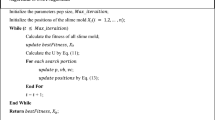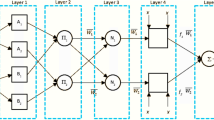Abstract
This study evaluated and compared several novel classification approaches to develop the most reliable stability model-based solution in the prediction of shallow footing’s allowable settlement. By applying the biogeography-based algorithm, this study presents an optimized metaheuristic classification approach with mathematical-based multi-layer perceptron neural network and fuzzy inference system to achieve a better assessment of the recognition of a complex failure phenomenon. By the contribution of a large number of finite element simulation, and considering seven key factors, the settlement of a shallow footing placed on a two-layered soil was measured as the target variable. Then, to change into the classification method, two overall situations of stability or failure were considered for the proposed soil layer. The ensemble of BBO–MLP and BBO–FIS are developed, and the results are evaluated by well-known accuracy indices. The results showed that employing BBO helps both MLP and FIS to have a better analysis. Besides, referring to the obtained total ranking scores of 6, 5, 11, and 8, respectively, for the MLP, FIS, BBO–MLP, and BBO–FIS, the BBO–MLP found to be the most accurate model, followed by BBO–FIS, MLP, and FIS.


Similar content being viewed by others
References
Cicek E, Guler E (2015) Bearing capacity of strip footing on reinforced layered granular soils. J Civ Eng Manag 21:605–614
Mosallanezhad M, Moayedi H (2017) Comparison analysis of bearing capacity approaches for the strip footing on layered soils. Arab J Sci Eng 42:3711–3722
Terzaghi K, Peck R, Mesri G (1943) Soil mechanics in engineering practice. Wiley, NewYork
Frydman S, Burd H (1997) Numerical studies of bearing-capacity factor N γ. J Geotech Geoenviron Eng 123:20–29
Silvestri V (2003) A limit equilibrium solution for bearing capacity of strip foundations on sand. Can Geotech J 40:351–361
Lotfizadeh MR, Kamalian M (2016) Estimating bearing capacity of strip footings over two-layered sandy soils using the characteristic lines method. Int J Civ Eng 14:107–116
Florkiewicz A (1989) Upper bound to bearing capacity of layered soils. Can Geotech J 26:730–736
Michalowski RL, Shi L (1995) Bearing capacity of footings over two-layer foundation soils. J Geotech Eng 121:421–428
Dewaikar D, Mohapatra B (2003) Computation of bearing capacity factor Nγ-Prandtl’s mechanism. Soils Found 43:1–10
Ghazavi M, Eghbali AH (2008) A simple limit equilibrium approach for calculation of ultimate bearing capacity of shallow foundations on two-layered granular soils. Geotech Geol Eng 26:535–542
Keskin MS, Laman M (2013) Model studies of bearing capacity of strip footing on sand slope. KSCE J Civ Eng 17:699–711
Ziaee SA, Sadrossadat E, Alavi AH, Shadmehri DM (2015) Explicit formulation of bearing capacity of shallow foundations on rock masses using artificial neural networks: application and supplementary studies. Environ Earth Sci 73:3417–3431
Moayedi H, Moatamediyan A, Nguyen H, Bui X-N, Bui DT, Rashid ASA (2019) Prediction of ultimate bearing capacity through various novel evolutionary and neural network models. Eng Comput 35:1–17
Bui X-N, Moayedi H, Safuan ARA (2019) Developing a predictive method based on optimized M5Rules–GA predicting heating load of an energy-efficient building system. Eng Comput 36:1–10
Liu L, Moayedi H, Rashid ASA, Rahman SSA, Nguyen H (2019) Optimizing an ANN model with genetic algorithm (GA) predicting load-settlement behaviours of eco-friendly raft-pile foundation (ERP) system. Eng Comput 36:1–13
Moayedi H, Hayati S (2018) Modelling and optimization of ultimate bearing capacity of strip footing near a slope by soft computing methods. Appl Soft Comput 66:208–219
Moayedi H, Mosallanezhad M, Mehrabi M, Safuan ARA (2018) A systematic review and meta-analysis of artificial neural network application in geotechnical engineering: theory and applications. Neural Comput Appl 31:1–24
Gao W, Guirao JLG, Basavanagoud B, Wu J (2018) Partial multi-dividing ontology learning algorithm. Inf Sci 467:35–58
Alnaqi AA, Moayedi H, Shahsavar A, Nguyen TK (2018) Prediction of energetic performance of a building integrated photovoltaic/thermal system thorough artificial neural network and hybrid particle swarm optimization models. Energy Convers Manage 183:137–148
Moayedi H, Mosallanezhad M, Mehrabi M, Safuan ARA, Biswajeet P (2019) Modification of landslide susceptibility mapping using optimized PSO-ANN technique. Eng Comput 35:967–984
Nguyen H, Bui X-N, Moayedi H (2019) A comparison of advanced computational models and experimental techniques in predicting blast-induced ground vibration in open-pit coal mine. Acta Geophys 28:1–13
Simon D (2008) Biogeography-based optimization. IEEE Trans Evol Comput 12:702–713
McCulloch WS, Pitts W (1943) A logical calculus of the ideas immanent in nervous activity. Bull Math Biophys 5:115–133
Gao W, Guirao JLG, Abdel-Aty M, Xi W (2019) An independent set degree condition for fractional critical deleted graphs. Discrete Continuous Dyn Syst-S 12:877–886
Nguyen H, Drebenstedt C, Bui X-N, Bui DT (2019) Prediction of blast-induced ground vibration in an open-pit mine by a novel hybrid model based on clustering and artificial neural network. Nat Resour Res 28:1–19
Gao W, Wang W, Dimitrov D, Wang Y (2018) Nano properties analysis via fourth multiplicative ABC indicator calculating. Arab J Chem 11:793–801
Nguyen H, Jamali Moghadam M, Moayedi H (2019) Agricultural wastes preparation, management and applications in engineering: a review. J Mater Cycles Waste Manage 21:1–13
Nguyen H, Mehrabi M, Kalantar B, Moayedi H, Muazu MA (2019) Potential of hybrid evolutionary approaches for assessment of geo-hazard landslide susceptibility mapping. Geomatics Nat Hazards Risk 10:1667–1693
Nguyen H, Moayedi H, Sharifi A, Amizah WJW, Safuan ARA (2019) Proposing a novel predictive technique using M5Rules-PSO model estimating cooling load in energy-efficient building system. Eng Comput 35:1–11
Shang Y, Nguyen H, Bui X-N, Tran Q-H, Moayedi H (2019) A novel artificial intelligence approach to predict blast-induced ground vibration in open-pit mines based on the firefly algorithm and artificial neural network. Nat Resour Res 28:1–15
Gao W, Wu H, Siddiqui MK, Baig AQ (2018) Study of biological networks using graph theory. Saudi J Biol Sci 25:1212–1219
Wang B, Moayedi H, Nguyen H, Foong LK, Rashid ASA (2019) Feasibility of a novel predictive technique based on artificial neural network optimized with particle swarm optimization estimating pullout bearing capacity of helical piles. Eng Comput 36:1–10
Yuan C, Moayedi H (2019) The performance of six neural-evolutionary classification techniques combined with multi-layer perception in two-layered cohesive slope stability analysis and failure recognition. Eng Comput 36:1–10
Zhang X, Nguyen H, Bui X, Tran Q, Nguyen D, Bui D, Moayedi H (2019) Novel soft computing model for predicting blast-induced ground vibration in open-pit mines based on particle swarm optimization and XGBoost. Nat Resour Res 28:1–11
Moayedi H, Hayati S (2018) Applicability of a CPT-based neural network solution in predicting load-settlement responses of bored pile. Int J Geomech 18:06018009
Moayedi H, Hayati S (2018) Artificial intelligence design charts for predicting friction capacity of driven pile in clay. Neural Comput Appl 31:1–17
Jang J-S (1993) ANFIS: adaptive-network-based fuzzy inference system. IEEE Trans Syst Man Cybern 23:665–685
Moayedi H, Raftari M, Sharifi A, Jusoh WAW, Rashid ASA (2019) Optimization of ANFIS with GA and PSO estimating α ratio in driven piles. Eng Comput 35:1–12
Author information
Authors and Affiliations
Corresponding author
Ethics declarations
Conflict of interest
The authors of this manuscript declaring of no conflict of interest to other published works.
Additional information
Publisher’s Note
Springer Nature remains neutral with regard to jurisdictional claims in published maps and institutional affiliations.
Rights and permissions
About this article
Cite this article
Moayedi, H., Nguyen, H. & Rashid, A.S.A. Novel metaheuristic classification approach in developing mathematical model-based solutions predicting failure in shallow footing. Engineering with Computers 37, 223–230 (2021). https://doi.org/10.1007/s00366-019-00819-9
Received:
Accepted:
Published:
Issue Date:
DOI: https://doi.org/10.1007/s00366-019-00819-9




